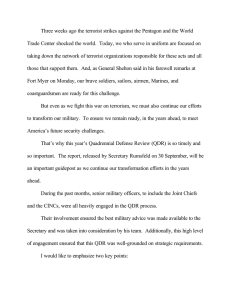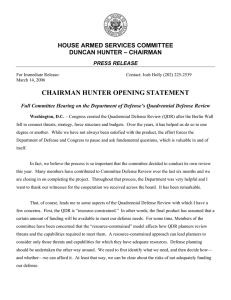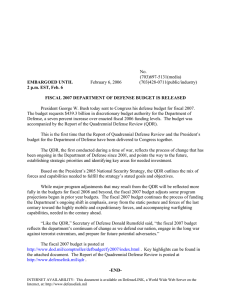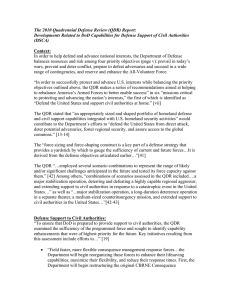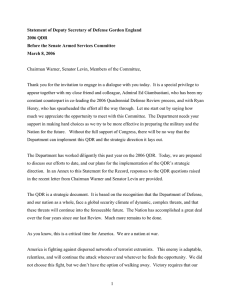Ms. Amanda Dory
advertisement
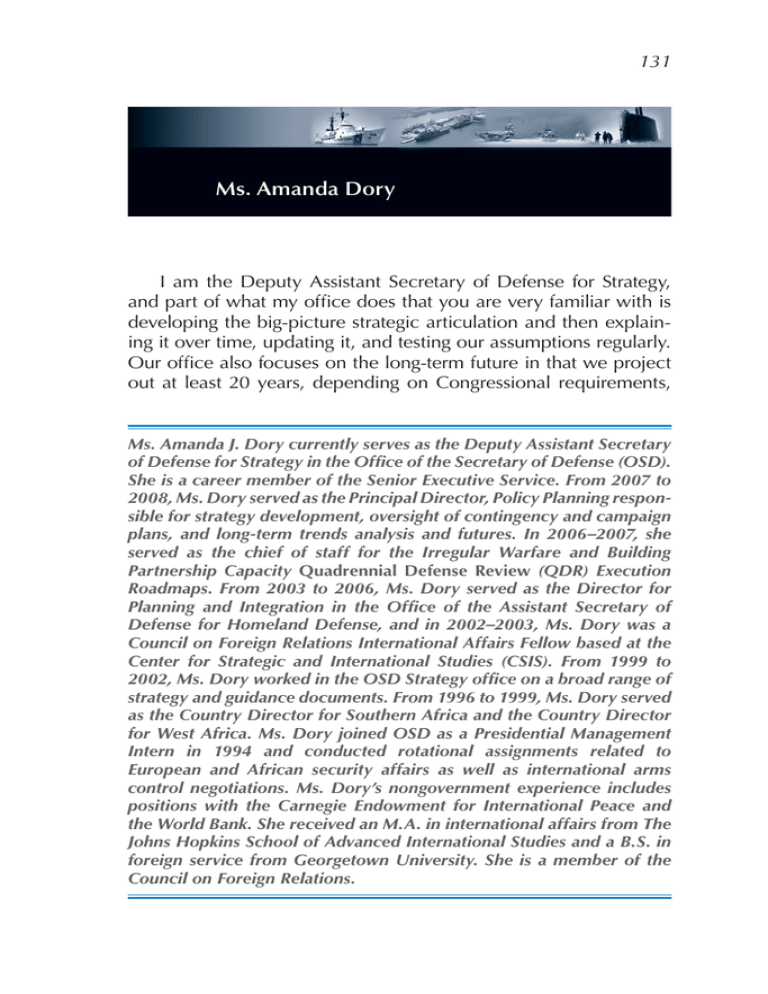
131 Ms. Amanda Dory I am the Deputy Assistant Secretary of Defense for Strategy, and part of what my office does that you are very familiar with is developing the big-picture strategic articulation and then explaining it over time, updating it, and testing our assumptions regularly. Our office also focuses on the long-term future in that we project out at least 20 years, depending on Congressional requirements, Ms. Amanda J. Dory currently serves as the Deputy Assistant Secretary of Defense for Strategy in the Office of the Secretary of Defense (OSD). She is a career member of the Senior Executive Service. From 2007 to 2008, Ms. Dory served as the Principal Director, Policy Planning responsible for strategy development, oversight of contingency and campaign plans, and long-term trends analysis and futures. In 2006–2007, she served as the chief of staff for the Irregular Warfare and Building Partnership Capacity Quadrennial Defense Review (QDR) Execution Roadmaps. From 2003 to 2006, Ms. Dory served as the Director for Planning and Integration in the Office of the Assistant Secretary of Defense for Homeland Defense, and in 2002–2003, Ms. Dory was a Council on Foreign Relations International Affairs Fellow based at the Center for Strategic and International Studies (CSIS). From 1999 to 2002, Ms. Dory worked in the OSD Strategy office on a broad range of strategy and guidance documents. From 1996 to 1999, Ms. Dory served as the Country Director for Southern Africa and the Country Director for West Africa. Ms. Dory joined OSD as a Presidential Management Intern in 1994 and conducted rotational assignments related to European and African security affairs as well as international arms control negotiations. Ms. Dory’s nongovernment experience includes positions with the Carnegie Endowment for International Peace and the World Bank. She received an M.A. in international affairs from The Johns Hopkins School of Advanced International Studies and a B.S. in foreign service from Georgetown University. She is a member of the Council on Foreign Relations. 132 Climate and Energy Proceedings 2011 and farther when we can. We use these forecasts to support longterm trends as well as to guide our development of force planning scenarios for the midterm and long term. Those tasks form the core of what our office does. On the basis of that brief description, you should be able to see how climate change and climate change trends would begin to intersect with our work. What I would like to do first today is to touch briefly on the Quadrennial Defense Review (QDR) (Figure 1). [1] I will not spend a lot of time going through the QDR in detail because I have a feeling that almost everyone in the audience has either read the QDR or heard me or others from my staff—I am joined here today by Ms. Esther McClure and Lieutenant Colonel Paul Schimpf—who have been out and about talking about the findings of the QDR. So I do not want to duplicate what you may have already heard; instead, I want to push ahead to the next step, to talk about what we are, or should, be doing about some of the important issues identified in the QDR and how we are progressing on that agenda. Figure 1. 2010 Quadrennial Defense Review The overall theme of 2010 Quadrennial Defense Review was rebalancing and reforming the DoD. In the months since its release, Chapter 5 Adapting Strategy and Operations to Climate 133 you have seen more of that, particularly with the efficiencies initiative that the Secretary of Defense led over the past year to find lower-risk areas in order to create resource availability for higher priorities. I think that is a rebalancing and reforming effort that we will continue, particularly as the nation grapples with how we get our defense and government budgets back in alignment as far as inputs and outputs. The first of the four strategic imperatives that we focused on in QDR 2010 is prevailing in today’s operations in Iraq, Afghanistan, and the global effort to defeat Al Qaeda and its associates. We placed that at the very top of the priority list, as you know. We also talked about preventing and deterring conflict—a strategic imperative that ties in directly with climate change projections in the midterm and in the long term; I will say more about the implications for conflict later on. The third strategic imperative was to prepare to defeat adversaries across a broad range of future contingencies. This was really a deliberate effort to try to take ourselves out of focusing on what had become, through the years, an almost canonical war fight. We have become very comfortable with these as analytical manifestations of potential future conflict. As a result, we continued to refine and update them without broadening our scope to think about a broader range of future contingencies to which the Department may be asked by the President to respond. Preparing for a broader scope and preparing for complexity are thus a key strategic imperative in the QDR. For the first time, this QDR raised the importance of preserving and enhancing the all-volunteer force to the level of the strategic imperative. We have certainly always addressed the roles and the responsibilities associated with caring for the all-volunteer force, but this QDR raised this issue to the level of a strategic imperative by recognizing that the all-volunteer force is at the heart of what the Department does. Based on Congressional guidance, the QDR also included a focus on climate change for the first time. Since you have probably read that section, I will not repeat it here; we can talk about it 134 Climate and Energy Proceedings 2011 further in the question and answer period, if there is particular interest. What we did was go through the potential impacts of climate change on our operating environment and on the Department’s roles and missions. We also looked at energy because we consider energy and climate change as highly inter-related or, if you like, two sides of the same coin. You cannot really think about climate change without also thinking about what is happening with energy production and consumption. I also want to touch briefly on what I will call upstream and downstream guidance that has come out since the QDR was published. There are two very important documents in this regard (Figure 2). The first is the National Security Strategy (NSS), which was released in May 2010. [2] The NSS is the overarching strategy for all of the national security departments and agencies. If you have been through the NSS, you have noted that it includes very forward-leaning guidance on climate change and that it talks about climate change as a danger that is real, urgent, and severe. The NSS calls on our nation’s security and development communities to work together to successfully integrate our approaches and the different elements of American power to address climate change now and in the future. Figure 2. Other Strategic Guidance Chapter 5 Adapting Strategy and Operations to Climate 135 Last month, Admiral Michael Mullen released the National Military Strategy (NMS). [3] In the hierarchy of strategies, the National Security Strategy is the most overarching. The Defense Strategy included within the QDR is subordinate to that and expresses the way that the defense toolkit—the assemblage of ways and means at our disposal—nests within the broader national security goals. The NMS takes it a step down by focusing on the military instrument, on military personnel and forces and the application of power, in particular. In the recently released NMS, you see again the importance of climate change in describing the future security environment. You also see a robust discussion of conflict prevention in which the Chairman emphasizes the savings that we believe are associated with preventive action as opposed to responsive action. I am sure that you are very familiar with the idea that the least costly wars are the ones that we do not fight; but it is that type of approach that is embedded in the NMS. Figure 3. Related Strategic Guidance Two other documents (Figure 3) have been released recently that round out the strategic discussion. The first is the Presidential Policy Directive on Global Development (PPD), which was 136 Climate and Energy Proceedings 2011 released in September 2010. [4] That PPD is a critical implementing step in what was laid out in the National Security Strategy. (In the Obama administration, PPDs serve the same function that National Security Presidential Directives or National Security Decision Directives have in prior administrations—they provide definitive guidance to all elements of the executive branch of the U.S. government.) Within the PPD, the President calls for the elevation of development as a core pillar of American power and articulates what is termed the 3-D approach, meaning the integration of development, diplomacy, and defense to reinforce and complement one another in a comprehensive approach to national security. This PPD in particular has three initiatives within it. One is a global health initiative, a second is a global food security initiative, and a third is a global climate change initiative. The National Security Council is actively managing the process of implementing all three. The final document I would like to raise to your attention is the QDDR. [5] If you have not had a chance to look through that document, it is the State Department’s first ever effort to do what the QDR does for the DoD. Completion of the QDDR took about a year. During the process, the State Department and the U.S. Agency for International Development looked both internally and externally at how they should organize and orient to address today’s challenges. The final report was released in December 2010. The DoD was highly supportive of the State Department in this effort, not only sharing the lessons learned from our experience in completing multiple QDRs through the years, but also providing personnel support when requested and actively participating where it was relevant toward their effort. I think the most important thing coming out of QDDR is the concept of civilian power as a complement to military power. As we try to balance what happens within national security approaches to problems, we have to find ways to accommodate the fact that the proverbial 800-pound gorilla, otherwise known as the military instrument, is the most resourced, the strongest, and therefore the most frequently used. Part of what Secretary of State Hillary Chapter 5 Adapting Strategy and Operations to Climate 137 Rodham Clinton has done in the QDDR is to craft her own version of “rebalance and reform” that really focuses on civilian power. I have one quote from that report that I want to share with you; I commend the entire report to your attention if you have not had a chance to look at it. Secretary Clinton speaks about civilian power as the combined force of women and men across the U.S. government, so it is not just focused within the State Department—it is women and men across the U.S. government who are practicing diplomacy, implementing development projects, strengthening alliances and partnership, preventing and responding to crises in conflict, and advancing America’s core interests. To me the framing of the idea of civilian power is, in addition to all the particular pieces of guidance and implementation that will follow, very powerful as we head forward. To summarize then, the key theme through all of the different strategic articulations is the concept of prevention and deterrence of conflict—that is the way it is described in the QDR, but conflict prevention is a common theme throughout all strategic guidance documents (Figure 4). Figure 4. Common Strategic Theme: Conflict Prevention 138 Climate and Energy Proceedings 2011 Within the department, we look at conflict prevention as a way to help shape the future security environment. At the same time, however, there are physical trends within the future security environment, like climate change and demographics, that also shape the future. Conflict prevention efforts are one way we can actively seek to shape outcomes instead of just responding to what is evolving and unfolding. As we have seen all too clearly over the past decade, state weakness can create as many challenges as state strength. We spend a lot of time in the DoD focusing on state strength, but part of the broadening of our suite of challenges is recognizing the challenges associated with state weakness. Among other things, weak states heighten the risk of conflict, like humanitarian crisis, and the potential for becoming terrorist sanctuaries. Figure 5. Notional Interagency Partnership on Climate Security Issues I am trying out Figure 5 for the first time. It is something we have been working on within the Strategy Office; it does not have official standing of any sort—it is a concept, if you will. But it is a Chapter 5 Adapting Strategy and Operations to Climate 139 concept for a holistic approach for how we could begin to, as a U.S. government, convert climate science and data into actionable, whole-of-government preventive efforts, as well as response efforts. I will try to explain what it is we are trying to convey in Figure 5 and then look forward to a discussion in the question and answer period. What we are starting to show, if you move from the top of Figure 5 down, are the various departments, agencies, and other federal entities that are involved on a particular line of effort. The output of each line of effort appears in the blue boxes along the right-hand side. The amount of effort being expended on these topics is very impressive. When you go to some of the interagency meetings, whether they are called by the State Department or the National Security staff, you see stakeholders from all the different agencies and departments that have equities, expertise, or activities underway. At the very top of Figure 5, you can see where entities such as NASA, the Department of Energy’s (DOE’s) national laboratories, the National Science Foundation (NSF), the DoD to include Navy, and the intelligence community (IC) are all collecting various types of climate data or working in the climate science arena. One of the challenges in this process is to create the translation function where the science and data eventually are converted into something that is tractable and actionable. Thus, the vertical arrow is intended to show how you move from science and data into model inputs, then into the creation of climate projections, then into the creation of more granular projections, for example, developing concepts for food, water, energy supplies, and security. The final piece, and the one critical for the DoD, is the national security assessment piece where the intelligence community comes in. You are all, I imagine, very familiar with the pioneering work of the National Intelligence Council and their National Intelligence assessments on climate change. Importantly, they are now working on a full-blown climate impact estimate. The translation function is particularly critical for the national security piece because that is where you start to bring to bear the human dimension and state behavior in a way that causes the 140 Climate and Energy Proceedings 2011 national security agencies to focus on what potential pathways lay ahead. In the bubble in the middle you see the role of the Executive Office of the President, the National Security staff focusing internationally, and the Council on Environmental Quality (CEQ), along with the Office of Science and Technology Policy (OSTP) focusing on domestic concerns. These organizations play key roles in terms of integration and guidance development and promulgation, such as the Presidential Policy Directive that I described earlier. The spectrum of actions appears at the very bottom of the chart. You can see that we have opportunities that are response related vis-à-vis climate change and security, and we have opportunities that are prevention related. Within each response, there is an array of responses. There are responses that happen—adaptiontype responses, for example—at a local level, at a regional level, or at a state level. There are also responses like migration that are based on a local manifestation of climate change. The other places where the DoD and other U.S. agencies tend to get engaged are humanitarian assistance and disaster response activities, particularly in the event of natural or man-made disasters. On the prevention side, as I have mentioned previously, climate change at a global level is not a particularly tractable challenge, and there are different ways of starting to make it more tractable. One of those is to develop a regional or a subregional focus and assessment process to support the planning and response development. Another way is to focus on some critical basic human needs such as water, food, and energy. The scarcity of any of those items, whether it is absolute scarcity or relative scarcity, is where one begins to see a range of adaptation responses. Those can include things like destabilizing migration or conflict over resources. In closing, I would like to make a few points about the way ahead. I have summarized these points in the list below and then describe them in greater detail: • It is no longer enough to simply recognize climate change as a national security issue. Now is the time to begin moving into the “planning and solutions phase.” Chapter 5 Adapting Strategy and Operations to Climate 141 • Debate about whether or not climate change constitutes a stand-alone “threat” or whether climate change, by itself, causes conflict are less helpful than identifying prudent actions to begin taking, given our improving understanding of vulnerabilities and risks. –– The DoD should apply a risk management framework to climate change considerations. –– Reducing the impacts of climate change will reduce the likelihood of conflict in vulnerable regions. The first point is that we need to move beyond simply congratulating ourselves for recognizing climate change as an important dimension of the future security environment. Instead, it is an area that we need to pay attention to on a day-to-day basis. The DoD crossed that bridge with the 2010 QDR. Many other departments and agencies preceded us and a few others have followed behind. In my view, we now need to be moving into the planning and solutions phase of the discussion. The DoD needs to figure out how it can most effectively plug into and enhance interagency efforts on mitigation and adaptation, working not only with the United States Agency for International Development and the State Department, but also with the full array of other actors who are engaged in prevention activities. We also need to think about adaptation solutions that we develop for our own installations, particularly domestic installations, and how we will transfer knowledge and work with civilian communities around those installations. In cases where the civilian communities are on the cutting edge as opposed to the DoD, we need to find ways to take advantage of their expertise as we think through adaptation planning. We also need to move beyond just asking questions such as: Is climate change a threat, is climate change a threat accelerant, or is climate change a threat multiplier? We need to focus beyond just the semantic tangles that we get ourselves into at times. They are not particularly helpful. Instead, we need to focus more on where are we with data, where we are with the science, and 142 Climate and Energy Proceedings 2011 where are we with assessments and projections and what can we do about them. As part of that, I think it is particularly important that we refocus our discussion on risks and vulnerabilities, particularly moving from global scales down to regional scales. REFERENCES 1. Department of Defense, 2010 Quadrennial Defense Review, 2010, http://www.defense.gov/qdr/images/QDR_as_of_ 12Feb10_1000.pdf. 2. The White House, National Security Strategy, May 2010, http:// www.whitehouse.gov/sites/default/files/rss_viewer/national_ security_strategy.pdf. 3. The Joint Chiefs of Staff, The National Military Strategy of the United States of America, 2011, http://www.jcs.mil//content/ files/2011-02/020811084800_2011_NMS_-_08_FEB_2011.pdf. 4. The White House, Fact Sheet: U.S. Global Development Policy, 2010, http://www.whitehouse.gov/the-press-office/2010/ 09/22/fact-sheet-us-global-development-policy. 5. U.S. Department of State, The First Quadrennial Diplomacy and Development Review: Leading Through Civilian Power, 2010, http://www.state.gov/documents/organization/153142.pdf.
